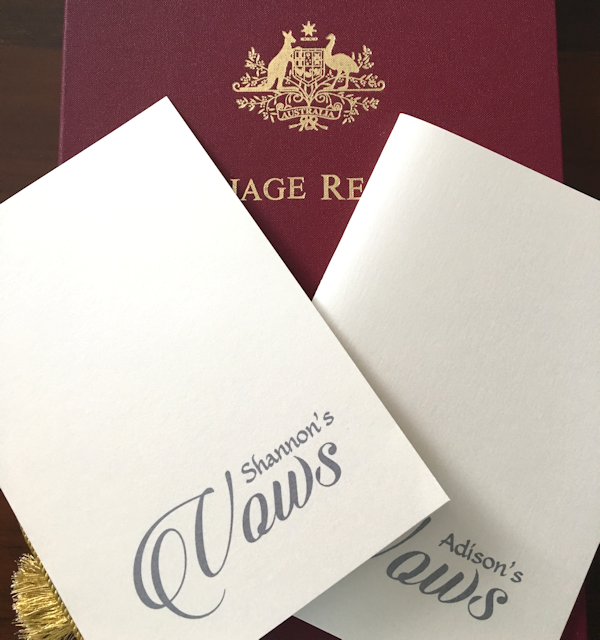Nail your Vows by doing
these 3 simple things
Categories: | Vows | Wedding Ceremony |
 I've
never met a couple who didn't want their exchange of
vows to go without a hitch on the day. And most couples
do worry about that. But the good news is, like
everything else about your wedding, preparation is key.
I've
never met a couple who didn't want their exchange of
vows to go without a hitch on the day. And most couples
do worry about that. But the good news is, like
everything else about your wedding, preparation is key.Despite being advised that they should start early, movies and TV shows regularly include scenes of one or both sweating over the task on the morning of the wedding. Neither a good look, nor a good idea. And no a way to guarantee a confident, stumble-free delivery.
However, doing 3 simple things before you start writing your vows will guarantee a flawless vow exchange on the day.
1. Make sure you are both on the same page
2. Decide on the logistics of how you will make your vows
3. Decide who else will be involved
Making
sure you are both on the same page
out
Your vows are your performance targets for your
marriage. That sounds unromantic, but making a marriage
work requires teamwork. Making sure your vow exchange on
the day flows smoothly, requires teamwork too. Which
means deciding together what sort of promises you will
make and how it will all come together on the day.Here's your decision check-list
- Legal vows only, or Legal Vows plus Personal Vows
(Personal Promises)
- Negotiate what we promise and work on our vows together (and make the same vows) or write individual vows
The
logistics
out
The Marriage Act only requires that you both say what we
call the legal vows, and that you say them separately,
because these are the statements that wil create your
marriage. How that is managed, however, is entirely a
personal choiceRepeat your vows after me
If you get married in Church, or in a Registry Office, you'll be given no choice. It's repeat after me. The person officiating your ceremony will feed you your lines, a phrase at a time, and you will repeat them.There are a lot of pluses to this method
- you can hold hands and look into one another's eyes
- if a microphone is being used, your celebrant can hold it for you, positioning it perfectly for each of you so everyone hears what you say
- if you are nervous you celebrant is close at hand to pace you, and to support you
- your photographer and videographer will have time to capture multiple images and both close-up and wider views.
Read your vows
While palm cards, or other 2-dimensional cards are very common, I prefer to go all out with the vows in bound booklet form. Not only is something that folds in the middle easier to hold (you just put your thumb at the fold and support it with the palm of your hand), it looks so much better in photos, and the added space means I can use bigger print to make it easier to read.- Reading from a card is the perfect choice if you personal promises are long
- You can hold the microphone yourselves, or your celebrant can hold it for you
- You will need to practice to make sure that you do frequently look up and into one another's eyes.
- Videographers prefer this method as it is less work for them to edit in the sound.
Of course, there is nothing to stop you reading your
vows from your phone, or even a teleprompter, but
always have a fallback plan in case of tech failure.
Regardless, your celebrant should always have a full
copy well before the ceremony.
Recite your vows from memory
Not something I'd recommend as it puts an awful lot of extra pressure on you. But on the couple of occasions when I've had a couple do that it has been absolutely wonderful. If you choose to do this make sure your celebrant has the full text of your vows in order to be able to prompt you if necessary. Make your personal promises spontaneous
... by working off a prompt card with
dot points rather than completely written out vows. Use a combination of the above
I often suggest to the couple that they repeat the legal vows after me, and read their personal promises. This allows the legal vows to be neatly differentiated from the personal promises, and gives them the confidence that there will be no slip-ups that might compromise the legality of their marriage.Do something different
The groom goes first. Then the bride. Then the rings. At least, that's the way it is done in church, and civil and celebrant-led weddings have meekly followed suit ever since. Something that couples dedicated to ensuring that they have an equal relationship, together with same-sex couples, have wrestled with, but not necessarily questioned, ever since. But it doesn't have to be that way.- Choose who will go first
The legal vows have to be said individually, so one of you will always need to say your legal vows after the other, but there is no legal requirement for who goes first. You can even put a bit of levity into the process by doing Rock, Paper, Scissors or tossing a coin to decide.
- Split your legal vows away from your personal
promises
You can both individually say your legal vows (and get them out of the way) and then both say your personal promises, either individually or in unison. There is a lot of power in making personal promises in stereo. And that method works well either when reading or when repeating after your celebrant.
- Interweave your personal promises
Instead of each saying your whole vow, take it sentence and sentence about. That can be great fun. - Exchange rings before
the vows
That's got a long history. In Roman times the rings were given before the marriage rites, and this carried through to the Catholic Church for some considerable time. As the ring you are given is a symbol of your best beloved's commitment to you, exchanging rings before the vows doesn't change their meaning. - Put the ring on the tip of your best beloved's
finger and say your vows, and then complete
the act of putting the ring on
Involving
others
out
I can just hear you saying "Huh?" We
are all so used to seeing the celebrant or clergy person
up front, actively involved in the couple's vows,
because it is Repeat after me.But ....
There is nothing in the Marriage Act that says anyone else has to be involved. So your celebrant can step out of the way, you can whip out your cards and just do it.
Or ...
You can invite someone near and dear to lead your through your vows. As long as you say your vows, and those present hear you do it, who prompts you, or how you do it is absolutely personal choice. You can also have others hand you your vows cards, if you're going to read your vows. Ditto with the rings. Personal choice.
Thanks for reading!
